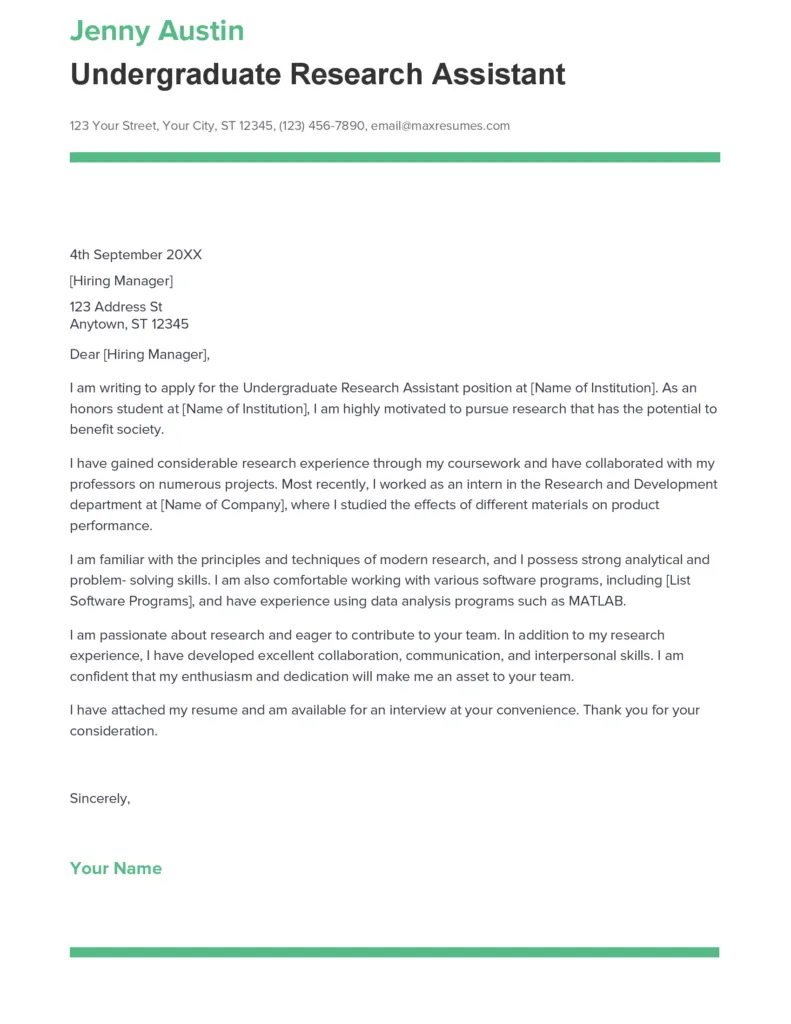Understanding the Research Assistant Cover Letter
A research assistant cover letter is a crucial document that accompanies your resume when applying for research assistant positions. It serves as your first impression, providing an opportunity to showcase your skills, qualifications, and enthusiasm for the role. Unlike your resume, which provides a factual overview of your experience, the cover letter allows you to narrate your story, explaining why you are the perfect fit for the specific research opportunity. It’s where you connect your skills to the requirements of the job and demonstrate your passion for research. A well-crafted cover letter can significantly increase your chances of landing an interview and ultimately, the position.
Key Components of a Winning Cover Letter
A compelling research assistant cover letter is comprised of several key components that work together to create a strong and persuasive argument for your candidacy. These components include a professional header, a captivating opening paragraph, well-structured body paragraphs that highlight your skills and experience, and a strong closing paragraph that expresses your enthusiasm and encourages further action. Each section serves a specific purpose, and together, they paint a comprehensive picture of your suitability for the role. Mastering these components is essential to creating a cover letter that stands out from the competition and grabs the attention of the hiring manager.
Header Section
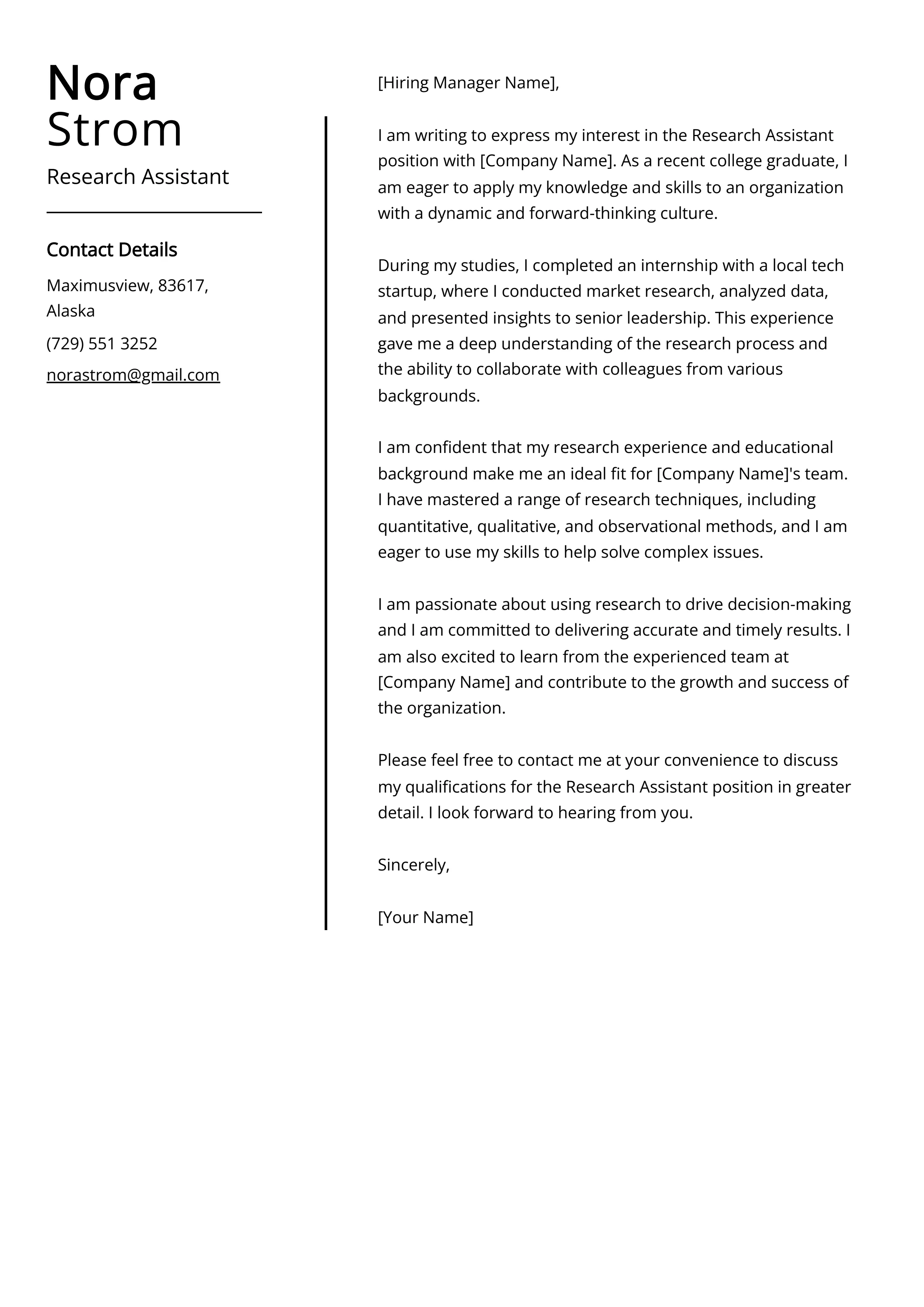
The header of your research assistant cover letter is the first element that a hiring manager sees, and it should project professionalism and attention to detail. This section typically includes your contact information, the date, and the recipient’s information. Ensure your contact information is accurate and up-to-date, including your full name, phone number, email address, and optionally, your LinkedIn profile URL. The date should be the current date, and the recipient information should include the hiring manager’s name, title, and the department or organization they work for. Correctly formatting the header sets a professional tone and makes it easy for the hiring manager to contact you. (Image: research-assistant-cover-letter-header.webp)
Applicant Information
Start with your full name, clearly displayed, followed by your address, phone number, and professional email address. Ensure your email address is professional. If you have a LinkedIn profile, including the URL is also a good idea, as it allows the hiring manager to quickly learn more about your professional background.
Date
Place the current date directly below your contact information. This indicates when you are submitting your application and helps the hiring manager keep track of when they received your application materials.
Recipient Information
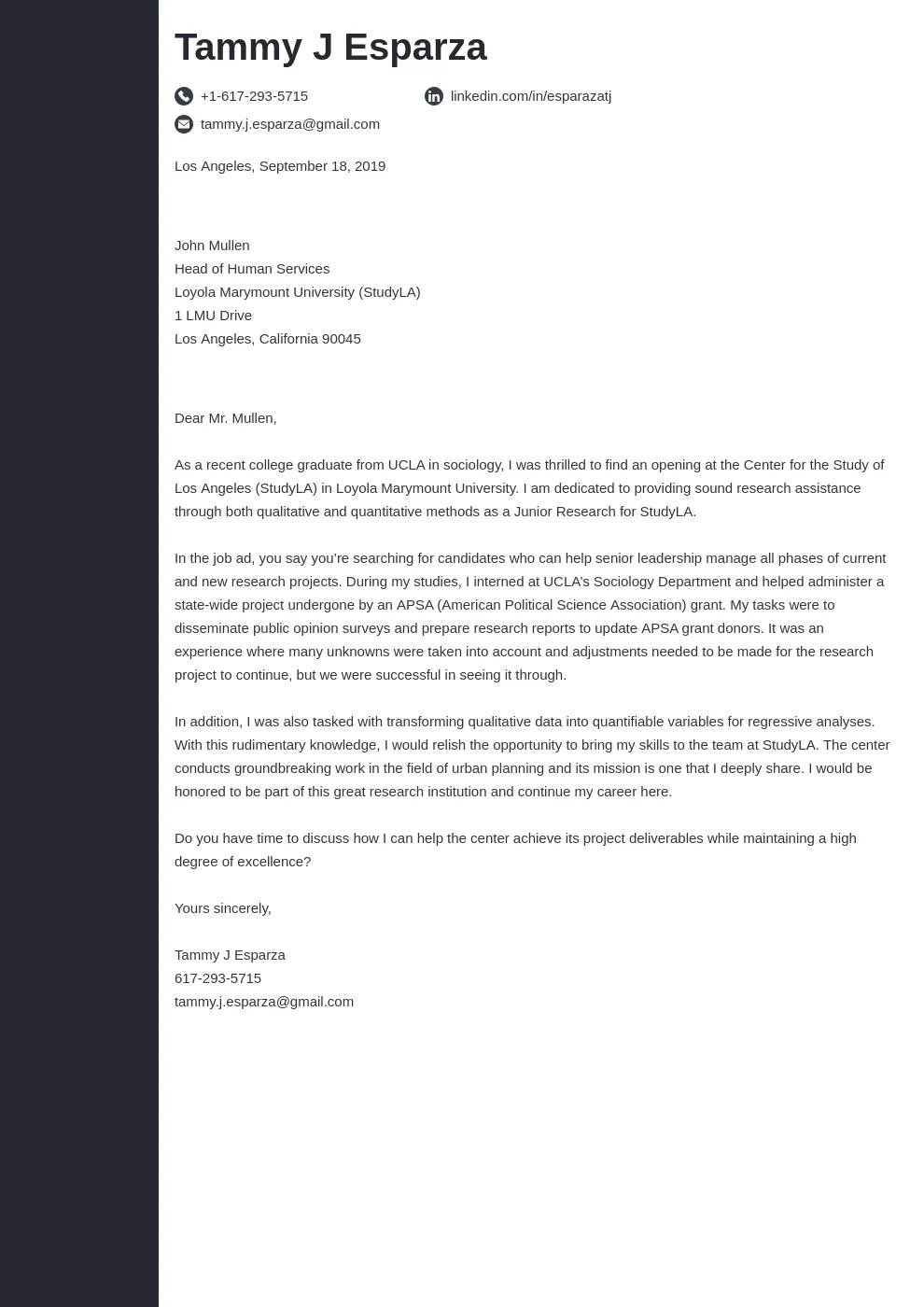
Include the hiring manager’s name, title, and the department or organization they work for. If possible, address the cover letter to a specific person; if not, research the department head. This personal touch shows that you have taken the time to research the organization and understand who will be reviewing your application. For example, ‘Dr. Emily Carter, Research Director, Department of Biology’.
Greeting the Hiring Manager
Begin your cover letter with a professional greeting. ‘Dear Dr. Carter’ or ‘Dear Hiring Manager’ are standard greetings. Avoid informal greetings like ‘Hi’ or ‘Hello’. If you are unsure of the name, use ‘Dear Hiring Committee’.
The Opening Paragraph Capturing Attention
The opening paragraph is your opportunity to immediately grab the reader’s attention and set the tone for the rest of your letter. It should clearly state the position you are applying for, where you found the job posting, and a brief, compelling statement about why you are interested in the position. This is where you want to make your first impression count. Focus on showcasing your enthusiasm for the research and the specific opportunity. Instead of a generic statement, try to demonstrate what excites you most about the research and why you chose this position over others.
Expressing Your Interest
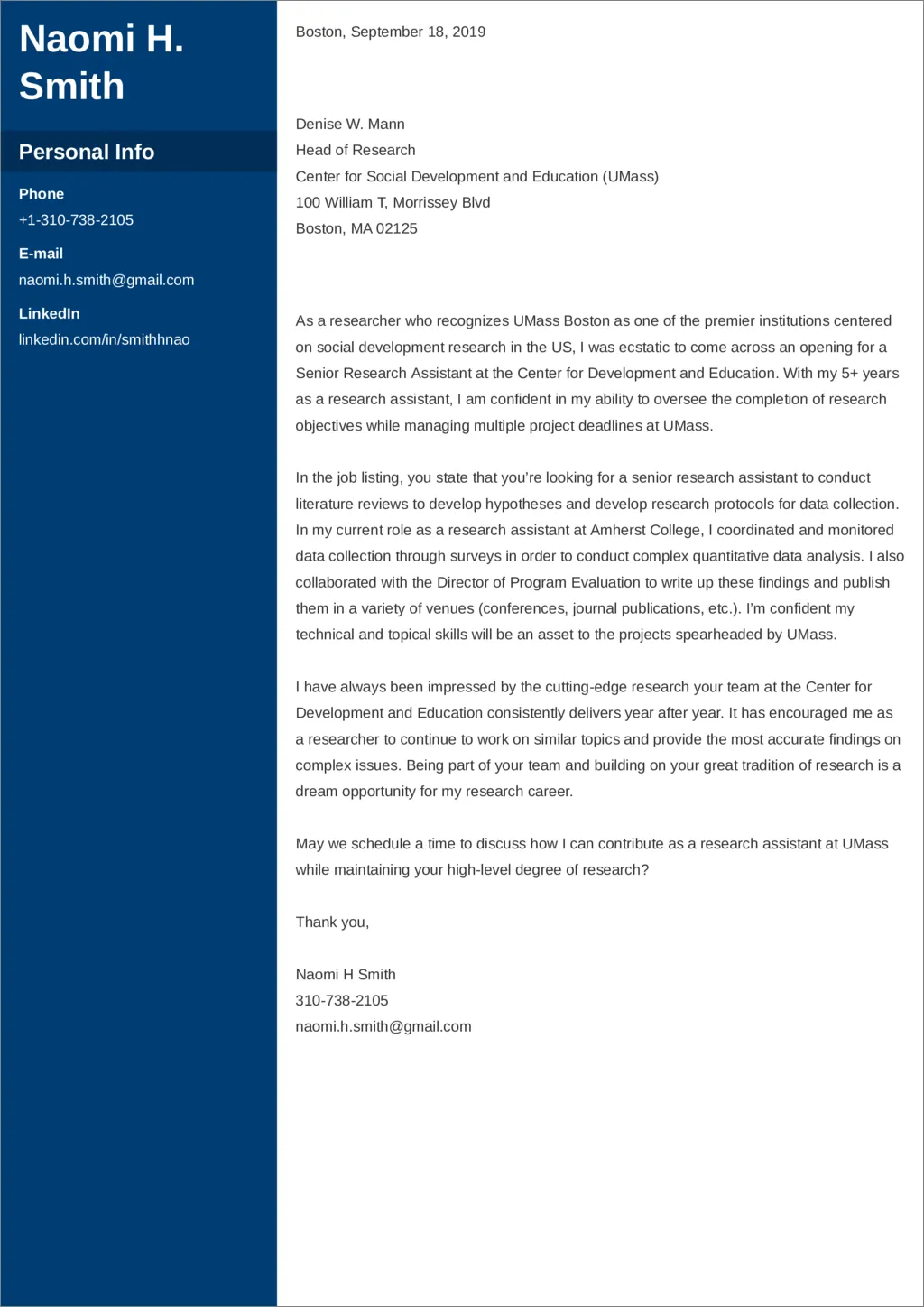
Start by clearly stating the position you are applying for. Then, immediately express your genuine interest in the role. Highlight what specifically attracts you to this research project or the organization. Showing genuine interest will grab the attention of the hiring manager and make them want to learn more about you.
Highlighting Relevant Skills
In the body paragraphs, you’ll want to showcase your skills and experience. This is the core of your cover letter, where you provide evidence of your qualifications. Divide the body into multiple paragraphs, each focusing on a different skill or experience that makes you a strong candidate. Use the job description as a guide to identify the key skills the employer is seeking. Then, provide specific examples of how you have demonstrated those skills in the past. Always quantify your accomplishments whenever possible to demonstrate your impact. (Image: research-assistant-cover-letter-skills.webp)
Showcasing Your Qualifications
Carefully review the job description and identify the key qualifications the employer is seeking. Focus your body paragraphs on these qualifications, demonstrating how your skills and experience align with the role’s requirements. Provide specific examples from your past experiences that highlight your abilities. Be direct and concise and show the employer why you are a strong fit for the position.
Demonstrating Research Experience
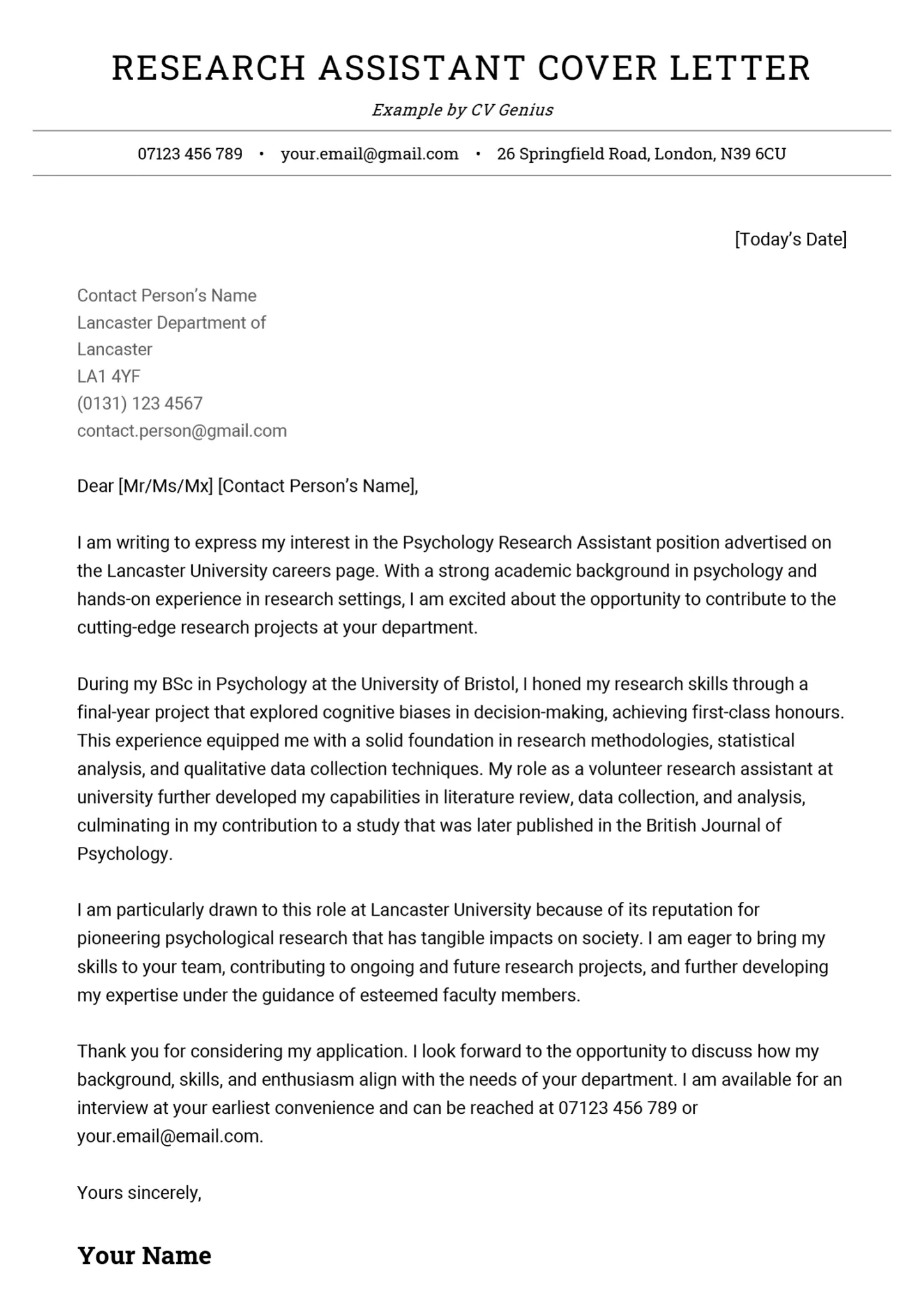
Research experience is vital. If you have any previous research experience, this is the section to elaborate on it. If you have assisted in previous research projects, briefly describe your responsibilities and any accomplishments you achieved. Emphasize any specific research techniques or methodologies you are familiar with, such as data analysis, laboratory techniques, or literature reviews. Be specific about the projects you worked on and how your contributions helped. (Image: research-assistant-cover-letter-experience.webp)
Mentioning Specific Projects
Mention specific projects you’ve worked on, the goals of the project, your specific role, and the results you helped achieve. This can be a thesis, a laboratory project, or any other relevant experience. Avoid generic descriptions. Provide details that showcase your contributions and the impact you made.
Quantifying Your Accomplishments
Wherever possible, quantify your accomplishments with numbers and data. For example, instead of saying ‘Assisted with data analysis’, say ‘Analyzed over 100 datasets, leading to the identification of key trends’. This provides concrete evidence of your skills and accomplishments, making your qualifications more tangible and convincing. Numbers make your impact more real.
Emphasizing Soft Skills
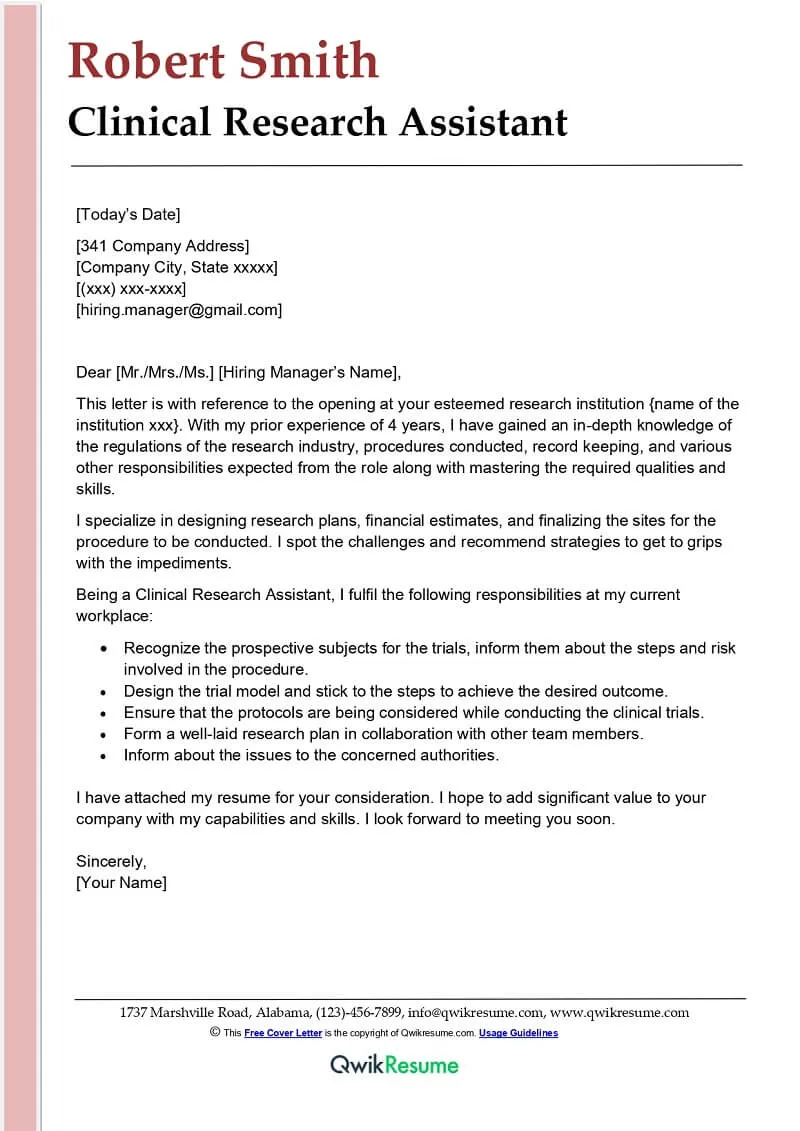
Research assistant positions require a range of soft skills. Highlight skills such as communication, teamwork, and problem-solving abilities. Use specific examples to illustrate how you have demonstrated these skills in your past experiences. This demonstrates you are not only technically proficient but also capable of working effectively in a team environment and contributing to research goals.
Showcasing Communication Skills
Highlight your ability to communicate clearly and effectively. Explain how you’ve communicated research findings, whether through presentations, written reports, or discussions with team members. Provide examples of situations where you successfully conveyed complex information in an understandable manner.
Highlighting Teamwork Abilities
Research often involves teamwork. Describe situations where you’ve collaborated effectively with others, highlighting your ability to contribute to a team environment. Give specific examples of how you’ve collaborated, supported colleagues, or helped achieve team goals. Mention any leadership roles you may have played within a team.
Demonstrating Problem-Solving Skills
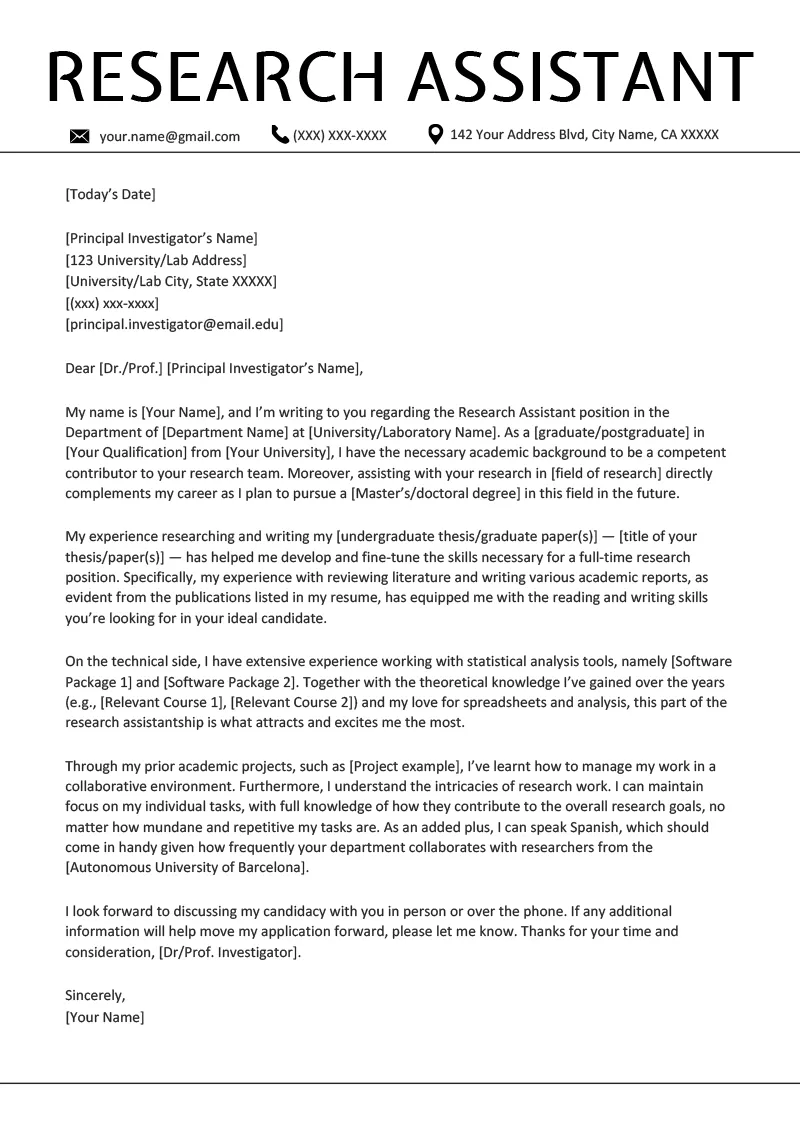
Research involves problem-solving. Describe situations where you have faced challenges and how you overcame them. This could involve troubleshooting technical issues, analyzing data, or adapting to changing research protocols. Emphasize your approach to problem-solving and how you used critical thinking to find solutions.
The Body Paragraphs Presenting Evidence
The body paragraphs are where you provide the evidence to support your claims. Each paragraph should focus on a specific skill or qualification that aligns with the job description. Use the STAR method (Situation, Task, Action, Result) to structure each example. Begin by describing the situation, outlining the task you were assigned, detailing the actions you took, and then explaining the positive results. This structured approach makes your accomplishments clear and easy to understand.
Paragraph 1 Skill 1
Choose a key skill that the job description emphasizes. Use the STAR method to describe a specific instance where you demonstrated this skill. Focus on showing not just telling; give real-world examples. For example, if the job requires data analysis skills, describe a project where you used data analysis software, the challenges you faced, the steps you took, and the insights you gained.
Supporting Information
Provide specific details to support your claims. This could include the name of the project, the software you used, the specific data analysis techniques you applied, and the positive outcomes. The more detailed you are, the more convincing your evidence will be. Always focus on quantifiable results when possible.
Paragraph 2 Skill 2
In your second body paragraph, choose another key skill from the job description. Again, use the STAR method, but choose a different skill. Ensure that your examples are diverse and highlight a variety of skills. If the job requires laboratory skills, describe a project where you applied those skills, detailing your specific techniques and any problems you solved.
Supporting Information
As with the first paragraph, include specific details and quantifiable results. This could include the equipment you used, the techniques you mastered, or the specific data you generated. Showing, rather than telling, will make your application more compelling.
Paragraph 3 Skill 3
If the job description requires it, you may need a third body paragraph. Choose yet another skill or experience to showcase. It’s best to stick to the main requirements of the job. If you have very different skills, consider combining some paragraphs. For example, if the job requires both project management and communication skills, you could combine examples.
Supporting Information
Again, ensure you provide specific details and focus on quantifiable results. Consider how your accomplishments have benefited the project, your team, or the overall research goals. Quantifiable results and specific examples make your application much more persuasive.
The Closing Paragraph Making a Call to Action
The closing paragraph should leave a lasting positive impression and encourage the hiring manager to take action. Restate your interest in the position, express your enthusiasm for the opportunity, and include a clear call to action. This is your last chance to convince the hiring manager you’re the perfect candidate. Keep it concise and enthusiastic. (Image: research-assistant-cover-letter-formatting.webp)
Expressing Enthusiasm
Reiterate your enthusiasm for the research project or organization. Briefly summarize why you believe you are a strong fit for the role and how your skills and experience align with their needs. This reinforces your interest and reminds the hiring manager of your key strengths. Restate your passion for the field and your excitement about contributing to the research.
Thanking the Hiring Manager
Express your gratitude for the hiring manager’s time and consideration. Thank them for reviewing your application and acknowledging their effort in the selection process. This is a sign of professionalism and respect for their time.
Including a Call to Action
Conclude with a clear call to action. State that you are eager to discuss your qualifications further and that you are available for an interview at their earliest convenience. Include your contact information again or offer a specific time and date. This is a polite yet proactive way of showing your enthusiasm and ensuring the hiring manager knows how to contact you.
Formatting and Proofreading Your Cover Letter
Formatting and proofreading are critical steps in creating a professional cover letter. Clean formatting and error-free writing demonstrate your attention to detail and professionalism. Reviewing the formatting ensures that the letter is easy to read and visually appealing. Proofreading ensures there are no typos, grammatical errors, or inconsistencies. Attention to detail in these areas will significantly increase your chances of success. (Image: research-assistant-cover-letter-tailoring.webp)
Choosing the Right Font and Formatting
Choose a professional, easy-to-read font such as Times New Roman, Arial, or Calibri. Keep the font size between 10 and 12 points. Use consistent formatting throughout your cover letter. Ensure there’s a clear layout with appropriate spacing between paragraphs and sections. Use single spacing within paragraphs and double spacing between paragraphs. Use left alignment and avoid justified text, as it can be difficult to read. Also, maintain a consistent margin size, preferably one inch on all sides.
Proofreading for Errors
Carefully proofread your cover letter for any spelling, grammatical, or punctuation errors. Read the document multiple times, slowly and deliberately. Consider reading the letter aloud to catch any awkward phrasing or errors. Use grammar and spell-checking tools, but do not rely on them entirely. They might miss errors. Always double-check your work, and if possible, have a trusted friend or colleague review your cover letter.
Reviewing and Refining Your Cover Letter
After writing your cover letter, take the time to review and refine your work. Ensure that the letter is concise, well-organized, and effectively communicates your qualifications. Check for any repetitive information and eliminate any unnecessary details. Make sure the letter is tailored to the specific job requirements. Finally, consider asking a career counselor or mentor to review your cover letter and provide feedback.
Common Mistakes to Avoid
There are several common mistakes that can significantly undermine your cover letter and reduce your chances of success. Avoiding these errors is crucial to presenting yourself in the best possible light. Some of these include using generic language, focusing only on yourself, ignoring the job description, and providing irrelevant information.
Using Generic Language
Avoid using generic, vague language that could apply to any applicant. Instead, use specific examples, quantifiable achievements, and tailored language that shows you understand the role and the organization’s needs. Generic statements show a lack of effort. Tailor the language to the specific research project or laboratory.
Focusing Only on Yourself
While it’s important to highlight your skills and accomplishments, avoid focusing solely on yourself. Frame your achievements in terms of how they benefited your previous projects, teams, and organizations. This shows you understand the importance of contributing to a research environment and demonstrates your ability to achieve common goals. Focus on how your skills and experience align with the needs of the research project.
Ignoring the Job Description
The job description is your roadmap for writing a compelling cover letter. Carefully review the job description and address each of the required qualifications and skills. If you ignore the job description, you risk missing key information. Tailor your letter to the requirements of the role, referencing specific keywords and requirements. The more the cover letter aligns with the job description, the better your chances of getting noticed.
Providing Irrelevant Information
Avoid including information that is not directly relevant to the research assistant position. Keep your cover letter focused on your research experience, technical skills, and relevant soft skills. Irrelevant information will detract from your strengths. Only mention achievements and experiences directly related to the job requirements.
Tailoring Your Cover Letter to Each Application
One of the most critical aspects of a successful research assistant cover letter is tailoring it to each specific job application. A generic cover letter will likely be overlooked. Tailoring demonstrates your interest in the particular role and shows the hiring manager that you have invested time and effort in understanding the requirements. This customization will increase your chances of success. (Image: research-assistant-cover-letter-research.webp)
Researching the Organization
Before writing your cover letter, research the organization and the research project or laboratory you are applying to. Visit the organization’s website, read publications from the research group, and learn about the specific research being conducted. Understanding the organization’s mission, values, and current projects will help you tailor your cover letter to their specific needs and demonstrate your genuine interest. Mentioning the specific goals of the research is a good strategy.
Customizing Your Cover Letter for the Specific Role
Customize your cover letter for each application. Reference the specific job description, highlighting the skills and qualifications the employer is seeking. Tailor your examples to directly align with the job requirements. Avoid reusing the same cover letter for different positions. Instead, take the time to modify and tailor each cover letter to match the specific role, showing the hiring manager that you have carefully reviewed the requirements and are the best fit for the role. (Image: research-assistant-cover-letter-customize.webp)
